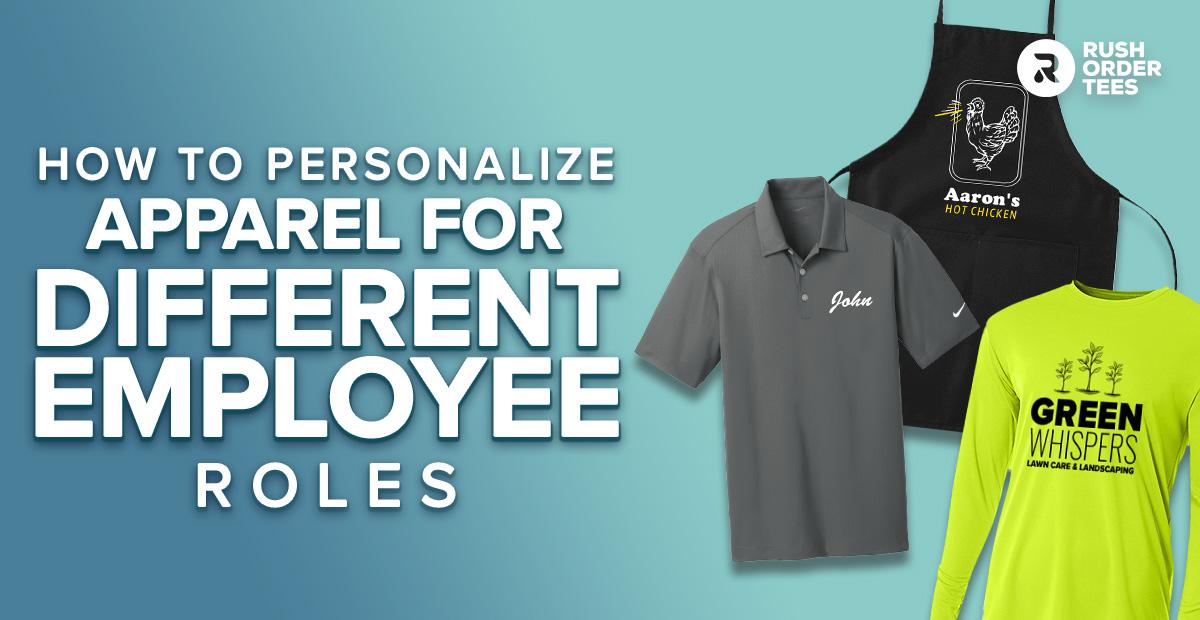

If the key to good team apparel is (no pun intended) uniformity, the key to great team apparel may be variety. There are a lot of reasons you might want to present a united aesthetic front among team members, but by customizing apparel by roles, you can still maintain that cohesiveness while visually distinguishing departments, responsibilities, or status.
Not sure where to start? From full uniforms to individual garments to company swag, here’s how to personalize apparel across employee roles in a way that doesn’t sacrifice branding or consistency.
Why Personalize Apparel By Role
Customized apparel for teams of any size can be effective in helping boost morale, unify team members, promote company culture, and strengthen branding. That’s a great baseline standard, but you can reap even more benefits like the ones below by personalizing that custom team apparel even further to cater to individual team member roles.
- Boost Morale: Employees feel valued and recognized when they're given apparel that signifies their role within an organization.
- Promote a Strong First Impression: A more polished, professional appearance that comes with structured branded attire can make a positive impact on clients and customers.
- Elevate Brand Perception: More dynamically personalized apparel can bump up the perceived value of your organization.
- Accommodate Need: You can adjust garment quality, composition, and utility based on the needs of the role.
- Show Appreciation: Personalized apparel shows team members the organization values them.
- Clarify Role Differentiation: Visually distinct uniforms make it easy for customers to see who holds which role.
Steps to Personalize Apparel for Different Roles
Ready to start personalizing your team’s custom workwear by role? Here’s how to get started and ensure you meet your branding and employee satisfaction goals.
1. Assess Needs by Role
First off, you’re going to need to know what your team needs to succeed. While your employees in the field might need uniforms that are weather-resistant and utilitarian, your office staff might just need custom polos that look polished and professional.
This is where an organizational chart or other HR documentation comes in handy. But if you don’t have any official company docs outlining every position’s responsibilities, you can just perform an audit of your own outlining every role at your company.
Talk with your managers or a representative sampling of the people in those roles to find out what they need from their apparel — especially around features like breathability, durability, flexibility, or added storage so you can fit the apparel to each role's specific work conditions.
2. Choose the Right Materials and Fabrics
Picking the right fabric ensures your teams have the right combination of comfort and functionality to meet the demands of their roles.
For example, you could consider moisture-wicking options like custom dri-fit shirts for physically active roles, wrinkle-resistant custom business apparel for office staff, or even stain-resistant options for staff who handle food and drinks. This step ensures the fabric aligns with the role’s needs for durability, maintenance, and comfort.
Again, it can help to get input from the actual individuals who’ll be wearing these garments so you can get a first-person perspective on the features they value.
3. Design for Different Roles
One of the key benefits of tailoring apparel by role is visual distinction. Once you’ve got the fabrics and features figured out for each role, you can think about design elements like color schemes, visual details, or other adjustments to suit each team member’s specific activities.
Keep in mind that you’ll still want to maintain a cohesive brand image, so you should stay within the confines of your brand colors, fonts, and style. These distinctions could be as simple as opting for an alternate color for managers, or as intricate as picking premium garment options with unique features and unique color schemes for individual team members. The idea is to balance tailored utility with aesthetic distinctions so you can highlight roles while presenting a united front.
4. Add Personal Touches
Everyone likes to stand out, even — or maybe even especially — when they’re wearing standardized clothing like a work uniform. A personal touch can help boost morale, help employees feel seen, and help team members preserve a sense of individuality without losing brand cohesion.
These personalization touches should add to the apparel without dramatically altering the core branding elements. For example, you could embroider names, job titles, or unique icons related to each team member’s role, or you could incorporate customized patches, unique colors, or other small design variations that reflect an individual's role while keeping the apparel part of the brand’s established look.
Best Practices for Implementing Role-Based Apparel Programs
So you’re bought into the idea of personalizing your company apparel for specific team roles, but what does that look like in action? Here are some of our top tips for customizing garments effectively.
- Understand the Roles: Before you make any judgment calls about the customizations for each garment, take the time to understand the fundamental duties, challenges, and daily realities of each role. Talk to team members, send out surveys, or test the roles firsthand.
- Keep It Uniform: Remember to not go so far down the personalization rabbit hole that you lose sight of core branding elements like company colors, logos, or established style guides.
- Be Thoughtful With Design: Incorporate branding in a way that aligns with the organization’s identity, but remember to keep it functional. Subtle embroidery, color accents, or logos can reinforce brand identity without overwhelming the design. Placement should be strategic, such as on the chest or sleeve, to keep your branding visible and professional.
- Roll Out Strategically: If you can get all your team members bought-in and have your custom apparel rolled out instantly, that’s the ideal. But for every other organization, you should announce any changes with enthusiasm, noting the benefits to individuals as well as the company.
- Incorporate Feedback: Implementing customization isn’t the end of the story — poll your teams and find out how they feel about the changes. Ultimately, you want them to feel acknowledged, seen, and cared for and for the personalization initiative to serve the brand and the employees at the same time.
How to Manage Inventory for Personalized Apparel
Depending on the size of your team, inventory management for personalized team apparel can be crucial. Remember that you’re committing to more complex inventory management processes since you’re accounting for more iterations of your apparel.
Start by picking a few core pieces, like custom t-shirts or custom jackets, rather than an entire wardrobe of bespoke items. With these essentials in place, it can be easier to customize on the fly for slight personalization like color accents, patches, and embroidery. This allows you to keep a manageable inventory of essentials ready for customizing as needed, reducing the number of unique items you need to stock.
Planning ahead also goes a long way. When you can print custom workwear to order, all you need is the printing and shipping time — no inventory space required.
Personalize Your Team Apparel by Role Today
In summary, personalizing apparel by role helps your team members feel a greater sense of independence, feel more recognized, and feel more capable of handling their roles.
Once you’re ready to bring these benefits to your teams, RushOrderTees’ custom printing services can help you get the apparel you need when you need it, from custom safety gear to custom sustainable apparel and everything in between.

About the Author
Based in New Mexico, Bryce Emley is a seasoned content writer and expert in the realms of custom apparel and eCommerce. Holding an MFA in Creative Writing, he seamlessly blends his passions, specializing in insightful content that bridges the gap between innovative apparel solutions and digital commerce trends. Beyond his professional pursuits, Bryce is an avid creator, channeling his creativity into poetry, screenplays, and creative nonfiction. In his leisure time, he has a penchant for collecting unique, vintage anime t-shirts, showcasing his love for both rare finds and the artistry of apparel design.
